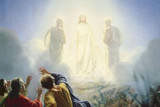The Eucharist and the Apocalypse
This article first appeared at: catholic.com
The (Catholic) Eucharist appears in a striking and mystical way in the book of Revelation.
On Easter morning, two disciples of Jesus are on their way from Jerusalem back to Emmaus. They might be husband and wife, but the text doesn’t say for certain. St. Luke names only one of the two: Cleopas. If they are a married couple, they might be Jesus’ aunt and uncle. (Hegesippus, a Christian writer from the second century, references “the Lord’s uncle, Clopas.”) If Cleopas and Clopas are the same person, then we know that his wife is Mary, one of the women who was at the Crucifixion (John 19:25), and that they have children named James and Joses (Mark 15:40), who are referred to as “brothers” of Jesus (Mark 6:3). (Since Hebrew lacked a word for cousins, cousins could be referred to as “brothers,” just as Abraham and Lot are called “brothers” in Genesis 13:8 and 14:14-16, despite being uncle and nephew.)
Whatever the case, these two disciples are walking the seven miles home from Jerusalem to Emmaus, “talking and discussing together,” when another traveler joins them (Luke 24:15). Noticing their sadness, he asks what they’re discussing, and they reply:
Concerning Jesus of Nazareth, who was a prophet mighty in deed and word before God and all the people, and how our chief priests and rulers delivered him up to be condemned to death, and crucified him. But we had hoped that he was the one to redeem Israel. Yes, and besides all this, it is now the third day since this happened. Moreover, some women of our company amazed us. They were at the tomb early in the morning and did not find his body; and they came back saying that they had even seen a vision of angels, who said that he was alive. Some of those who were with us went to the tomb, and found it just as the women had said; but him they did not see (vv. 19-24).
If Cleopas and Clopas are the same person, his wife and likely walking companion was one of those “women of our company” who were the first witnesses of the empty tomb (Luke 24:10). The other traveler then replies, “O foolish men, and slow of heart to believe all that the prophets have spoken! Was it not necessary that the Christ should suffer these things and enter into his glory?” (25-26).
On arriving back in Emmaus, they invite the traveler to join them. There, while “at table with them, he took the bread and blessed, and broke it, and gave it to them. And their eyes were opened and they recognized him; and he vanished out of their sight” (vv. 30-31).

It’s only here that Cleopas and his companion realize two things. First, that the traveler who had joined them was Jesus (Luke explains in verse 16 that “their eyes were kept from recognizing him”). Second, that Jesus had opened up the Old Testament scriptures to them in a radically new way: “Did not our hearts burn within us while he talked to us on the road, while he opened to us the scriptures?” (v. 32). They immediately arise and make the seven-mile journey back to Jerusalem, where they tell the apostles about how Jesus “was known to them in the breaking of the bread” (v. 35).
This is an important detail that we often overlook. Jesus is the key to unlocking the Old Testament scriptures: “Beginning with Moses and all the prophets, he interpreted to them in all the scriptures the things concerning himself” (Luke 24:27). But they realize who he is, and how he makes sense of Scripture, only once they recognize him “in the breaking of the bread.”
This expression is eucharistic: the “breaking of the bread” is how Luke describes the early Christian Eucharist (Acts 2:42, 46), and the way he describes this scene closely resembles the way he describes the Last Supper. Look at the careful way Luke presents this moment: Jesus “took the bread,” “blessed” it, “broke it,” and “gave it to them” (v. 30).
Why does Luke use four verbs to describe this moment? After all, presumably, he knows we know how to eat bread, and he’s not trying to reassure us that they said their prayers before eating.
It’s not a coincidence that this is just how Luke and the other Evangelists recount Jesus’ actions at the Last Supper. In Luke: “He took bread, and when he had given thanks he broke it and gave it to them, saying, ‘This is my body which is given for you. Do this in remembrance of me’” (22:19). In Matthew: “Jesus took bread, and blessed, and broke it, and gave it to the disciples and said, ‘Take, eat; this is my body’” (26:26). It’s those same four actions again: Jesus takes, blesses, breaks, and gives. Jesus reveals himself and the scriptures are unlocked.
We see this in another, more mystical way in the book of Revelation. St. John sees a scroll “sealed with seven seals” in “the right hand of him who was seated on the throne” (5:1). A “strong angel” proclaims with a loud voice, “Who is worthy to open the scroll and break its seals?” (v. 2). When “no one in heaven or on earth or under the earth” (v. 3) is able to open the scroll, John bursts into tears. One of the heavenly elders then says to him, “Weep not; lo, the Lion of the tribe of Judah, the Root of David, has conquered, so that he can open the scroll and its seven seals” (v. 5).
But what John sees next isn’t a lion; it’s a lamb. More specifically, “I saw a Lamb standing, as though it had been slain” (v. 6), who then takes the scroll, while heaven breaks out into a chorus: “Worthy art thou to take the scroll and to open its seals, for thou wast slain and by thy blood didst ransom men for God from every tribe and tongue and people and nation, and hast made them a kingdom and priests to our God, and they shall reign on earth” (vv. 9-10).
There’s a tremendous irony in this passage. We expect the “strong angel” to be able to open the seals, but he can’t; no creature can. And then we expect the Son of God to be able to open it because he’s the conquering Lion of Judah. But Christ appears not in strength, but in humility: “a Lamb standing, as though it had been slain.” Even this image is paradoxical: the slain are not known for standing upright. It’s an image of Jesus conquering through his meekness and self-sacrifice and death.
But it’s not only an image of Christ the crucified, but of Christ as the slain lamb, recalling both the Old Testament Passover and the Lord’s Supper in which “Christ, our paschal lamb, has been sacrificed” (1 Cor. 5:7). So it’s only when we know Jesus Christ in this way that everything else is unlocked. Otherwise, some scrolls remain sealed off to our understanding. We don’t get to experience our hearts burning within us.
The eucharistic Jesus is the key. The Catholic understanding of the Eucharist is that Jesus gives us himself in the Eucharist. When we receive it, we receive him in his entirety. The Eucharist isn’t just a symbol, or just Jesus’ “spiritual presence.” The Eucharist is really Jesus.
The Narrow Gate Blog
Catholic social media runs red-hot for “new” Shroud of Turin research
Originally published by Catholicweekly.com.auThe Catholic world has finally caught up with The Catho...
A Drop in the Ocean
written by Cath GaleAfter caring for my Dad full time for 14 months, while he lived with a brain tum...
The miraculous making of MacKillop docu-film
Originally published by The Catholic Weekly When pre-production began on a docu-fict...
The Assumption of Mary in History
This article first appeared at: catholic.com. The doctrine of the Assumption of Mary began with...
What is the Transfiguration?
Originally published by www.EWTN.com The Transfiguration of Jesus is one of the key events in Jesus’...
Sailing Back to Byzantium: Art of Michael Galovic, Yarra and Hunter Arts Press, 2024.
Rod Pattenden, July 2024This lavish, large format publication on the work of iconographer Michael Ga...






